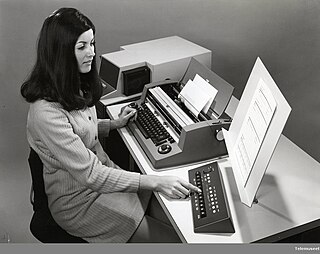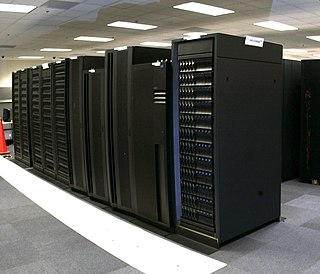
The IBM System/360 (S/360) is a family of mainframe computer systems announced by IBM on April 7, 1964, and delivered between 1965 and 1978. They were the first family of computers designed to cover both commercial and scientific applications and a complete range of applications from small to large. The design distinguished between architecture and implementation, allowing IBM to release a suite of compatible designs at different prices. All but the only partially compatible Model 44 and the most expensive systems use microcode to implement the instruction set, featuring 8-bit byte addressing and fixed point binary, fixed point decimal and hexadecimal floating-point calculations.

A tape drive is a data storage device that reads and writes data on a magnetic tape. Magnetic-tape data storage is typically used for offline, archival data storage. Tape media generally has a favorable unit cost and a long archival stability.

The IBM 7950, also known as Harvest, was a one-of-a-kind adjunct to the Stretch computer which was installed at the United States National Security Agency (NSA). Built by IBM, it was delivered in 1962 and operated until 1976, when it was decommissioned. Harvest was designed to be used for cryptanalysis.
Disk Operating System/360, also DOS/360, or simply DOS, is the discontinued first member of a sequence of operating systems for IBM System/360, System/370 and later mainframes. It was announced by IBM on the last day of 1964, and it was first delivered in June 1966. In its time, DOS/360 was the most widely used operating system in the world.

Linear Tape-Open (LTO), also known as the LTO Ultrium format, is a magnetic tape data storage technology used for backup, data archiving, and data transfer. It was originally developed in the late 1990s as an open standards alternative to the proprietary magnetic tape formats that were available at the time. Upon introduction, LTO rapidly defined the super tape market segment and has consistently been the best-selling super tape format. The latest generation as of 2021, LTO-9, can hold 18 TB in one cartridge.
In computer storage, a tape library is a physical area that holds magnetic data tapes. In an earlier era, tape libraries were maintained by people known as tape librarians and computer operators and the proper operation of the library was crucial to the running of batch processing jobs. Although tape libraries of this era were not automated, the use of tape management system software could assist in running them.
FICON is the IBM proprietary name for the ANSI FC-SB-3 Single-Byte Command Code Sets-3 Mapping Protocol for Fibre Channel (FC) protocol. It is a FC layer 4 protocol used to map both IBM's antecedent channel-to-control-unit cabling infrastructure and protocol onto standard FC services and infrastructure. The topology is fabric utilizing FC switches or directors. Valid rates include 1, 2, 4, 8, 16, and 32 Gigabit per second data rates at distances up to 100 km.
The IBM 3850 Mass Storage System (MSS) was an online tape library used to hold large amounts of infrequently accessed data. It was one of the earliest examples of nearline storage.

Storage Technology Corporation was a data storage technology company headquartered in Louisville, Colorado. New products include data retention systems, which it calls "information lifecycle management" (ILM).
A virtual tape library (VTL) is a data storage virtualization technology used typically for backup and recovery purposes. A VTL presents a storage component as tape libraries or tape drives for use with existing backup software.

The IBM MT/ST was a model of the IBM Selectric typewriter, built into its own desk, integrated with magnetic tape recording and playback facilities, located in an attached enclosure, with controls and a bank of relays. It was released by IBM in 1964. It recorded text typed on 1/2" magnetic tape, approximately 25 kilobytes per tape cassette, and allowed editing and re-recording during playback. It was the first system marketed as a word processor. Most models had two tape drives, which greatly facilitated revision and enabled features such as mail merge. An add-on module added a third tape station, to record the combined output of playback from the two stations.

9-track tape is a format for magnetic-tape data storage, introduced with the IBM System/360 in 1964. The 1⁄2 inch (12.7 mm) wide magnetic tape media and reels have the same size as the earlier IBM 7-track format it replaced, but the new format has eight data tracks and one parity track for a total of nine parallel tracks. Data is stored as 8-bit characters, spanning the full width of the tape. Various recording methods have been employed during its lifetime as tape speed and data density increased, including PE, GCR, and NRZI. Tapes come in various sizes up to 3,600 feet (1,100 m) in length.
Magnetic-tape data storage is a system for storing digital information on magnetic tape using digital recording.

The IBM Storage product portfolio includes disk, flash, tape, NAS storage products, storage software and services. IBM's approach is to focus on data management.

OS/360, officially known as IBM System/360 Operating System, is a discontinued batch processing operating system developed by IBM for their then-new System/360 mainframe computer, announced in 1964; it was influenced by the earlier IBSYS/IBJOB and Input/Output Control System (IOCS) packages for the IBM 7090/7094 and even more so by the PR155 Operating System for the IBM 1410/7010 processors. It was one of the earliest operating systems to require the computer hardware to include at least one direct access storage device.

The IBM 3592 is a series of enterprise-class tape drives and corresponding magnetic tape data storage media formats developed by IBM. The first drive, having the IBM product number 3592, was introduced under the nickname Jaguar. The next drive was the TS1120, also having the nickname Jaguar. As of October 2023, the latest and current drive is the TS1170. The 3592 line of tape drives and media is not compatible with the IBM 3590 series of drives, which it superseded. This series can store up to 50 TB of data (uncompressed) on a cartridge and has a native data transfer rate of up to 400 MB/s. In August 2023 IBM announced the TS1170 tape drive with 50TB cartridges, more than 2.5 times larger than LTO-9 cartridges.
The IBM 3570 is a series of tape drives and corresponding magnetic tape data storage media formats developed by IBM. The storage technology and media were introduced using the name Magstar MP, combining the IBM storage brand name Magstar with MP for MultiPurpose. The IBM product number 3570 was associated with the tape drives and libraries that used the Magstar MP media.

The IBM Selectric was a highly successful line of electric typewriters introduced by IBM on 31 July 1961.
The Linear Tape File System (LTFS) is a file system that allows files stored on magnetic tape to be accessed in a similar fashion to those on disk or removable flash drives. It requires both a specific format of data on the tape media and software to provide a file system interface to the data.










